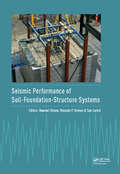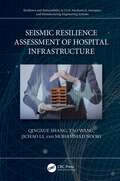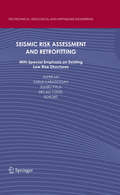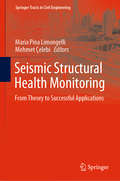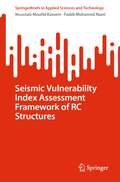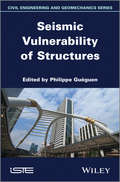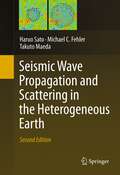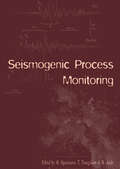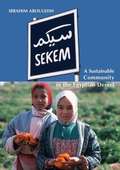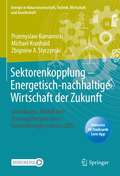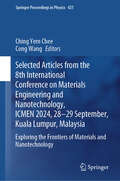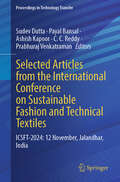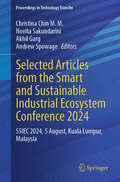- Table View
- List View
Seismic Performance of Soil-Foundation-Structure Systems: Selected Papers from the International Workshop on Seismic Performance of Soil-Foundation-Structure Systems, Auckland, New Zealand, 21-22 November 2016
by Nawawi Chouw, Rolando P. Orense & Tam LarkinSeismic Performance of Soil-Foundation-Structure Systems presents invited papers presented at the international workshop (University of Auckland, New Zealand, 21-22 November 2016). This international workshop brought together outstanding work in earthquake engineering that embraces a holistic consideration of soilfoundation-structure systems. For example, the diversity of papers in this volume is represented by contributions from the fields of shallow foundation in liquefiable soil, spatially distributed lifelines, bridges, clustered structures (see photo on front cover), sea floor seismic motion, multi-axial ground excitation, deep foundations, soil-foundation-structurefluid interaction, liquefaction-induced settlement and uplift with SFSI. A fundamental knowledge gap is manifested by the isolated manner geotechnical and structural engineers work. A holistic consideration of soil-foundation-structures systems is only possible if civil engineers work collaboratively to the mutual benefit of all disciplines. Another gap occurs by the retarded application of up-to-date research findings in engineering design practices. Seismic Performance of Soil-Foundation-Structure Systems is the outcome from the recognized need to close this gap, since it has been observed that a considerable delay exists between published research findings and application of the principles revealed by the research. Seismic Performance of Soil-Foundation-Structure Systems will be helpful in developing more understanding of the complex nature of responses these systems present under strong earthquakes, and will assist engineers in closing the gaps identified above.
Seismic Resilience Assessment of Hospital Infrastructure (Resilience and Sustainability in Civil, Mechanical, Aerospace and Manufacturing Engineering Systems)
by Tao Wang Mohammad Noori Qingxue Shang Jichao LiHealthcare facilities or hospital systems are classified as some of the most critical infrastructure systems when responding to natural disasters. Seismic Resilience Assessment of Hospital Infrastructure systematically presents a suite of novel techniques developed by the authors and their team for seismic resilience assessment of hospital infrastructure, with particular emphasis on seismic tests and fragility models of hospital equipment, resilience assessment of single hospital buildings and emergency departments, and post-earthquake functionality of urban hospital infrastructures.Features: Presents a state-of-the-art review on hospital resilience Develops seismic fragility model database for hospital equipment based on shaking table tests Provides a road map for effective and efficient methods necessary for assessing and improving seismic resilience of hospital systems and other critical engineering systems Expertly summarizes outcomes of many important research projects sponsored by various research agencies, including the National Natural Science Foundation of China
Seismic Resistance of Vernacular Timber Frames with Infills: Case Studies from Japan and Romania
by Andreea Dutu Yoshihiro YamazakiThis book provides an engineer’s perspective on the traditional construction methods for timber frames with infills, focusing on traditional paianta houses in Romania and minka houses in Japan to provide insights into the construction, seismic behavior, and design considerations of such structures.The nuances of each country’s traditional construction methods are considered, as well as the shared seismic culture and the similar functionality and local materials used for the houses, plus challenges from earthquake loading and fire. The efforts to preserve traditional houses in Romania are contrasted with Japan’s regulatory framework for traditional residential construction methods. Strengthening solutions are also proposed for timberframed houses with infills, considering various causes of degradation.• Introduces examples from non- seismic and seismic- prone countries.• Provides a comparative analysis of worldwide examples.• Presents design examples illustrating the integration of traditional architecture with modern design standards.The book serves as a comprehensive guide to the engineering intricacies of traditional houses in Romania and Japan for engineers and architects, with practical applications for new constructions worldwide.
Seismic Retrofit of Existing Reinforced Concrete Buildings
by Stelios AntoniouSeismic Retrofit of Existing Reinforced Concrete Buildings Understand the complexities and challenges of retrofitting building infrastructure Across the world, buildings are gradually becoming structurally unsound. Many were constructed before seismic load capacity was a mandatory component of building standards, and were often built with low-quality materials or using unsafe construction practices. Many more are simply aging, with materials degrading, and steel corroding. As a result, efforts are ongoing to retrofit existing structures, and to develop new techniques for assessing and enhancing seismic load capacity in order to create a safer building infrastructure worldwide. Seismic Retrofit of Existing Reinforced Concrete Buildings provides a thorough book-length discussion of these techniques and their applications. Balancing theory and practice, the book provides engineers with a broad base of knowledge from which to approach real-world seismic assessments and retrofitting projects. It incorporates knowledge and experience frequently omitted from the building design process for a fuller account of this critical engineering subfield. Seismic Retrofit of Existing Reinforced Concrete Buildings readers will also find: Detailed treatment of each available strengthening technique, complete with advantages and disadvantages In-depth guidelines to select a specific technique for a given building type and/or engineering scenario Step-by-step guidance through the assessment/retrofitting process Seismic Retrofit of Existing Reinforced Concrete Buildings is an ideal reference for civil and structural engineering professionals and advanced students, particularly those working in seismically active areas.
Seismic Retrofitting: Learning from Vernacular Architecture
by Humberto Varum Mariana R. Correia Paulo B. LourencoLocal communities have adapted for centuries to challenging surroundings, resulting from unforeseen natural hazards. Vernacular architecture often reveals very intelligent responses attuned to the environment. Therefore, the question that emerged was: how did local populations prepare their dwellings to face frequent earthquakes? It was to respond to this gap in knowledge, that the SEISMIC-V research project was instigated, and this interdisciplinary international publication was prepared. The research revealed the existence of a local seismic culture, in terms of reactive or preventive seismic resistant measures, able to survive, if properly maintained, in areas with frequent earthquakes. The fundamental contribution and aims of the publication were to enhance:-The disciplinary interest in vernacular architecture;-Its contribution to risk mitigation in responding to natural hazards;-To encourage academic and scientific research collaboration among different disciplines;-To contribute to the improvement of vernacular dwellings, which half of the world’s population still inhabits nowadays. Fifty international researchers and experts presented case studies from Latin America, the Mediterranean, Eastern and Central Asia and the Himalayas region, with reference to 20 countries, i.e. Algeria, Bolivia, Bhutan, Chile,China, Egypt, El Salvador, Greece, Haiti, Italy, Japan, Mexico, Morocco, Nepal, Nicaragua, Peru, Romania, Taiwan, Turkey and a closer detailed analysis of Portugal. This publication brings together 43 contributions, with newperspectives on seismic retrofitting techniques and relevant data, addressing vernacular architecture; an amazing source of knowledge, and to this day, home to 4 billion people.
Seismic Risk Analysis of Nuclear Power Plants
by Wei Liu Wei Jiang Wei-Chau Xie Shun-Hao NiSeismic Risk Analysis of Nuclear Power Plants addresses the needs of graduate students in engineering, practicing engineers in industry, and regulators in government agencies, presenting the entire process of seismic risk analysis in a clear, logical, and concise manner. It offers a systematic and comprehensive introduction to seismic risk analysis of critical engineering structures focusing on nuclear power plants, with a balance between theory and applications, and includes the latest advances in research. It is suitable as a graduate-level textbook, for self-study, or as a reference book. Various aspects of seismic risk analysis - from seismic hazard, demand, and fragility analyses to seismic risk quantification, are discussed, with detailed step-by-step analysis of specific engineering examples. It presents a wide range of topics essential for understanding and performing seismic risk analysis, including engineering seismology, probability theory and random processes, digital signal processing, structural dynamics, random vibration, and engineering risk and reliability.
Seismic Risk Assessment and Retrofitting
by Alper Ilki Ercan Yuksel Faruk Karadogan Sumru PalaMany more people are coming to live in earthquake-prone areas, especially urban ones. Many such areas contain low-rise, low-cost housing, while little money is available to retrofit the buildings to avoid total collapse and thus potentially save lives. The lack of money, especially in developing countries, is exacerbated by difficulties with administration, implementation and public awareness. The future of modern earthquake engineering will come to be dominated by new kinds of measuring technologies, new materials developed especially for low-rise, low-cost buildings, simpler and thus lower cost options for retrofitting, cost cutting and raising public awareness. The book covers all the areas involved in this complex issue, from the prevention of total building collapse, through improvement techniques, to legal, financial, taxation and social issues. The contributors have all made valuable contributions in their own particular fields; all of them are or have been closely involved with the issues that can arise in seismic zones in any country. The recent research results published here offer invaluable pointers to practicing engineers and administrators, as well as other scientists whose work involves saving the lives and property of the many millions of people who live and work in hazardous buildings.
Seismic Structural Health Monitoring: From Theory to Successful Applications (Springer Tracts in Civil Engineering)
by Maria Pina Limongelli Mehmet ÇelebiThis book includes a collection of state-of-the-art contributions addressing both theoretical developments in, and successful applications of, seismic structural health monitoring (S2HM). Over the past few decades, Seismic SHM has expanded considerably, due to the growing demand among various stakeholders (owners, managers and engineering professionals) and researchers. The discipline has matured in the process, as can be seen by the number of S2HM systems currently installed worldwide. Furthermore, the responses recorded by S2HM systems hold great potential, both with regard to the management of emergency situations and to ordinary maintenance needs. The book’s 17 chapters, prepared by leading international experts, are divided into four major sections. The first comprises six chapters describing the specific requirements of S2HM systems for different types of civil structures and infrastructures (buildings, bridges, cultural heritage, dams, structures with base isolation devices) and for monitoring different phenomena (e.g. soil-structure interaction and excessive drift). The second section describes available methods and computational tools for data processing, while the third is dedicated to hardware and software tools for S2HM. In the book’s closing section, five chapters report on state-of-the-art applications of S2HM around the world.
Seismic Vulnerability Assessment and Retrofitting Strategies for Masonry Infilled Frame Building (Springer Theses)
by Andre Filipe FurtadoThis book reports on a comprehensive experimental characterization of the material, mechanical and dynamic properties of masonry infill walls. It analyses the critical parameters affecting their out-of-plane seismic behavior, including the effects of the panel support conditions, gravity load, and previous damage. Further, it offers an extensive review of infill masonry strengthening strategies and reports on the experimental assessment of various textile-reinforced mortar (TRM) strengthening solutions. It also presents the development, implementation and calibration of a numerical model to simulate the infill panels’ seismic behavior, with the corresponding findings of various tests to assess the seismic vulnerability of an infilled RC structure. All in all, this outstanding PhD thesis offers a comprehensive review of masonry infill walls, and a timely overview of numerical and experimental methods for testing and preventing the out-of-plane seismic collapse of RC buildings.
Seismic Vulnerability Index Assessment Framework of RC Structures (SpringerBriefs in Applied Sciences and Technology)
by Fadzli Mohamed Nazri Moustafa Moufid KassemThis book represents a significant step toward a new contribution in the process of developing the seismic vulnerability index. This is accomplished by releasing or reducing the role of the rapid visual screening that is created by the opinions and decisions of experts, which depend on observations made while investigating the vulnerability damages caused by earthquakes. Alternatively, the computational analytical technique is preferable since it can be effective in determining the seismic vulnerability index before the occurrence of an earthquake by modeling the most affected influencing parameters that regulate the building performance. In addition, the seismic vulnerability index is supported by the vulnerability curves, which describe the probability of damages and are used to estimate the economic damage grade for each building which is the topic of inquiry. In the end, this helps to establish a clear vision and sort of recommendations for engineers and specialists to follow in order to take into consideration certain indices and factors before designing any specific structure. Because of this, the simplified work is utilized to manage and put into action measures that will protect against the effects of seismic events before an earthquake really occurs. In addition to this benefit, the work that has been done is of significant assistance to the authorities that are accountable for the restoration of the preexisting buildings and the cultural heritages.
Seismic Vulnerability of Structures (Wiley-iste Ser.)
by Philippe GueguenThis book is focused on the seismic vulnerability assessment methods, applied to existing buildings, describing several behaviors and new approaches for assessment on a large scale (urban area). It is clear that the majority of urban centers are composed of old buildings, designed according to concepts and rules that are inadequate to the seismic context. How to assess the vulnerability of existing buildings is an essential step to improve the management of seismic risk and its prevention policy. After some key reminders, this book describes seismic vulnerability methods applied to a large number of structures (buildings and bridges) in moderate (France, Switzerland) and strong seismic prone regions (Italy, Greece). Contents 1. Seismic Vulnerability of Existing Buildings: Observational and Mechanical Approaches for Application in Urban Areas, Sergio Lagomarsino and Serena Cattari. 2. Mechanical Methods: Fragility Curves and Pushover Analysis, Caterina Negulescu and Pierre Gehl. 3. Seismic Vulnerability and Loss Assessment for Buildings in Greece, Andreas J. Kappos. 4. Experimental Method: Contribution of Ambient Vibration Recordings to the Vulnerability Assessment, Clotaire Michel and Philippe Guéguen. 5. Numerical Model: Simplified Strategies for Vulnerability Seismic Assessment of Existing Structures, Cédric Desprez, Panagiotis Kotronis and Stéphane Grange. 6. Approach Based on the Risk Used in Switzerland, Pierino Lestuzzi. 7. Preliminary Evaluation of the Seismic Vulnerability of Existing Bridges, Denis Davi. About the Authors Philippe Guéguen is a Senior IFSTTAR Researcher at ISTerre, Joseph Fourier University Grenoble 1, France
Seismic Wave Propagation and Scattering in the Heterogeneous Earth: Second Edition
by Haruo Sato Michael C. Fehler Takuto MaedaSeismic waves - generated both by natural earthquakes and by man-made sources - have produced an enormous amount of information about the Earth's interior. In classical seismology, the Earth is modeled as a sequence of uniform horizontal layers (or spherical shells) having different elastic properties and one determines these properties from travel times and dispersion of seismic waves. The Earth, however, is not made of horizontally uniform layers, and classic seismic methods can take large-scale inhomogeneities into account. Smaller-scale irregularities, on the other hand, require other methods. Observations of continuous wave trains that follow classic direct S waves, known as coda waves, have shown that there are heterogeneities of random size scattered randomly throughout the layers of the classic seismic model. This book focuses on recent developments in the area of seismic wave propagation and scattering through the randomly heterogeneous structure of the Earth, with emphasis on the lithosphere. The presentation combines information from many sources to present a coherent introduction to the theory of scattering in acoustic and elastic materials and includes analyses of observations using the theoretical methods developed. The second edition especially includes new observational facts such as the spatial variation of medium inhomogeneities and the temporal change in scattering characteristics and recent theoretical developments in the envelope synthesis in random media for the last ten years. Mathematics is thoroughly rewritten for improving the readability. Written for advanced undergraduates or beginning graduate students of geophysics or planetary sciences, this book should also be of interest to civil engineers, seismologists, acoustical engineers, and others interested in wave propagation through inhomogeneous elastic media.
Seismic Waves in Soil Layers: Soil Behaviour During Recent Strong Earthquakes
by Olga V. PavlenkoThis book describes recent studies of soil behaviour in strong ground motion – one of the most important and problematic issues in engineering seismology. Destructive earthquakes worldwide show us the damage of structures located on soil foundations; therefore, reliable and adequate estimations of in situ soil behaviour during strong motion are needed. The effects of soil response proved to be more complicated and diverse than we thought previously. Additionally to well-known amplification of seismic waves in near-surface softer layers, resonant phenomena and nonlinearity of soil response, during the 2011 Tohoku earthquake, we observed soil hardening and generation of abnormally high accelerations. The author suggests a method for studying these effects in situ, to forecast soil behaviour in future earthquakes. The method is based on processing records of seismic vertical arrays, which are widely developed in the world and should help us in understanding soil response during earthquakes.The book is addressed to a wide range of seismologists, geotechnical earthquake engineers and physicists.
Seismogenic Process Monitoring: Proceedings of a joint Japan-Poland Symposium on Mining and Experimental Seismology, Kyoto, Japan, November 1999
by H. Ogasawara T. Yanagidani M. AndoThis volume covers near-source monitoring of seismogenic process, in situ probing of active faults, and techniques for seismogenic process monitoring. It is the outcome of multi-disciplinary investigations conducted over a large range of size scales.
Sekem: A Sustainable Community in the Egyptian Desert
by Ibrahim Abouleish Markus KirchgessnerThe Egyptian desert can be a hostile place. Yet in 1977, Dr Ibrahim Abouleish founded a new agricultural and social settlement on seventy hectares of desert land in Belbes, 60 km north east of Cairo. The Sekem initiative was born. Dr Abouleish's goals were to build a new type of sustainable community. His vision was for a farm which grew biodynamic crops and plants out of the harsh desert sand. Where the workers and residents were given holistic primary health care. Where their children were well-educated in the sciences. A place which could sell its wares and be self-sufficient and self-sustaining. A place where Islamic religion and Western technology could come together in harmony. Nearly thirty years later and Sekem has gone from strength to strength. In 1981 it shipped its first medicinal herbs to the USA; by 2004, it oversaw a network of over 800 farms across Egypt and the Sudan, producing high quality organic crops, herbs, fruits and vegetables. Its mobile health units work with local rural populations and it has brought about real social change. This is the story of Sekem -- the original vision, the challenges and hard work, and the eventual successes -- in Ibrahim Abouleish's own words. Stunningly illustrated with colour photographs throughout.
Sektorenkopplung – Energetisch-nachhaltige Wirtschaft der Zukunft: Grundlagen, Modell und Planungsbeispiel eines Gesamtenergiesystems (GES) (Energie in Naturwissenschaft, Technik, Wirtschaft und Gesellschaft)
by Zbigniew A. Styczynski Przemyslaw Komarnicki Michael KranholdDen Kern des Buches bildet die Darstellung einer systematischen, durchgehenden und logischen Kette in das gekoppelte Gesamtenergiesystem (GES) der Zukunft, die zur vollständig-nachhaltigen Nutzung der regenerativen Energien führen wird. So werden einheitliche Modelle vorgeschlagen die für die Teilsysteme/Sektoren durchgehend anwendbar sind und die Optimierung des gesamten GES erlauben. Entsprechende Algorithmen und Ansätze werden mit zahlreichen Beispielen illustriert. Dies wird im Kontext der Bestrebungen zur vollen Integration der erzeugten Energie aus erneuerbaren Quellen in das GES eingebettet. Die übergeordnete Rolle der IT Systeme für sicheren Betrieb wurde im Buch betont. Die Relevanz der richtigen Zuordnung der Technologien zu Anwendungsfällen wird herausgearbeitet und daraus abgeleitete notwendige Schritte werden technisch und organisatorisch (Normung) betrachtet. Besonderes Augenmerk wird auf die didaktische Darlegung des Stoffes gelegt, um diese neue, schwierige und komplexe Problematik „so einfach wie möglich, aber nicht einfacher“ [nach Einstein], vorzustellen.
Selbination: Ein hybrides Meta-Lernverfahren zur automatischen Selektion und Kombination geeigneter Prognosemodelle für die Produktionsplanung
by Mirko KückGenaue Nachfrageprognosen sind von signifikanter Bedeutung für Unternehmen in Supply Chains. Dies gilt insbesondere für Unternehmen, die Produkte auf Lager produzieren oder für Handelsunternehmen. Diese müssen die Kundennachfrage in regelmäßigen Intervallen prognostizieren, weshalb automatische Prognoseverfahren notwendig sind. Alle bisher entwickelten Verfahren lassen sich entweder als reine Selektions- oder als reine Kombinationsansätze klassifizieren und es existieren bislang keine hybriden Verfahren zwischen Selektion und Kombination. Zur Nutzung der Vorteile der beiden Ansätze wird in diesem Buch ein hybrides Verfahren vorgestellt, das für jede Zeitreihe datengetrieben entweder selektiert oder kombiniert. Das sogenannte Selbinationsverfahren besteht aus einem Meta-Modell zur Schätzung der Eignungswahrscheinlichkeiten verschiedener Prognoseverfahrenskandidaten und einer Selektionsfunktion, die auf Basis der Eignungswahrscheinlichkeiten sowie einer sogenannten Hybriditätsgrenze ein oder mehrere Prognoseverfahren selektiert. Das neuartige Verfahren wird in einer umfassenden empirischen evaluiert und erzielt im Durchschnitt signifikant bessere Prognosen als etablierte Verfahren aus dem Stand der Forschung.
Selbstgeführte Stromrichter am Gleichspannungszwischenkreis
by Steffen BernetVerfahren der Leistungselektronik ermöglichen die Anpassung, Wandlung und Dosierung elektrischer Energie. Daher sind sie von großer Bedeutung für Industrie, Energieversorgung, Verkehr, Medizin und Kommunikationstechnik. Der Autor behandelt in dem Lehrbuch das Teilgebiet selbstgeführter AC-DC-Wandler als Bestandteil von Umrichtern mit Gleichspannungszwischenkreis. Aufbau, Funktion, Modulation und Regelung des Zweipunkt-Stromrichters werden ausführlich und verständlich beschrieben. Geeignet für Studierende, aber auch für Ingenieure in der Industrie.
Selbstgeführte Stromrichter am Gleichspannungszwischenkreis: Funktion, Modulation und Regelung
by Steffen BernetVerfahren der Leistungselektronik ermöglichen die Anpassung, Wandlung und Dosierung elektrischer Energie. Daher sind sie von großer Bedeutung für Industrie, Energieversorgung, Verkehr, Medizin und Kommunikationstechnik. Der Autor behandelt in dem Lehrbuch das Teilgebiet selbstgeführter AC-DC-Wandler als Bestandteil von Umrichtern mit Gleichspannungszwischenkreis. Aufbau, Funktion, Modulation und Regelung des Zweipunkt-Stromrichters werden ausführlich und verständlich beschrieben. Geeignet für Studierende, aber auch für Ingenieure in der Industrie.
Select Proceedings of the 8th Indian International Conference on Air Quality Management (Lecture Notes in Civil Engineering #582)
by S. M. Shiva Nagendra Praveen C. Ramamurthy Sotiris Vardoulakis Kraichat Tantrakarnapa Richard J. BallThis book presents select proceedings of the Indian International Conference on Air Quality Management (IICAQM) and examines the latest advancements in theories, technologies, and applications in the area of air quality management and health impacts. The topics covered include modelling, monitoring, and managing urban air quality and sustainably achieving clean air and healthy urban conditions. The book also discusses air pollution in urban areas involving multiple processes, such as the generation of pollutants and their release from a source, their transport and transformation, removal from the atmosphere and their effects on human health, visibility, materials, and ecosystems. The book is a valuable reference for researchers and professionals interested in air quality management and allied fields.
Selected Articles from the 2nd International Conference on Advanced Nanomaterials and Applications: ICANA 2024; 10-12 July, Amaravati, India (Springer Proceedings in Physics #413)
by Yogendra Kumar Mishra Giribabu Lingamallu Tufan GhoshThis book comprises selected articles from the 2nd International Conference on Advanced Nanomaterials and Applications (ICANA 2024) held from 10 to 12 July at Amaravati in India. It presents recent developments in the fields of nanoscale sciences. The topics covered in this book include energy storage and conversion, bio- and healthcare materials, sensors and actuators, functional materials, optical materials, and computational and simulation methods. This book is useful for researchers and professionals working in the various fields of nano- and material science.
Selected Articles from the 8th International Conference on Architecture and Civil Engineering: ICACE 2024, 12-13 December, Penang, Malaysia (Lecture Notes in Civil Engineering #635)
by Mokhtar Awang Lin Yola Elham Maghsoudi Nia Mohamad Ferdaus Noor Aulady Marina TraykovaThis book highlights the latest research developments in civil engineering and architectural materials, reflecting the innovative works presented at the 8th International Conference on Architecture and Civil Engineering, and Technology (ICACE 2024) held on 12-13 December at Parkroyal Hotel Penang, Malaysia. It provides an opportunity to explore cutting-edge findings and advancements that are shaping the future of these fields. By bringing together experts and scholars from around the world, ICACE 2024 aims to promote collaboration and knowledge sharing, contributing to the ongoing evolution of architecture and civil engineering.
Selected Articles from the 8th International Conference on Materials Engineering and Nanotechnology, ICMEN 2024, 28-29 September, Kuala Lumpur, Malaysia: Exploring the Frontiers of Materials and Nanotechnology (Springer Proceedings in Physics #421)
by Cong Wang Ching Yern CheeThis volume delves into recent innovative approaches and advancements in the dynamic fields of materials engineering and nanotechnology. It offers a comprehensive exploration of diverse topics, ranging from advanced materials synthesis and characterization to nanoscale science and engineering, functional composite materials, and sustainable technologies. Curated from the esteemed 8th International Conference on Material Engineering and Nanotechnology (ICMEN 2024) held in Kuala Lumpur, Malaysia, on September 28th-29th, 2024, this book presents peer reviewed articles authored by experts across various domains of materials engineering and nanotechnology. The significance of these proceedings lies in their profound impact on advancing the collective knowledge and understanding within the scientific community. By disseminating cutting-edge research findings and innovations, this publication serves as a catalyst for collaboration, idea generation, and the expansion of scientific horizons. With its broad scope and relevance, this book is indispensable for materials and nanotechnology engineers, scholars, and researchers across science, technology, and engineering disciplines.
Selected Articles from the International Conference on Sustainable Fashion and Technical Textiles: ICSFT-2024: 12 November, Jalandhar, India (Proceedings in Technology Transfer)
by Ashish Kapoor Payal Bansal Sudev Dutta C. C. Reddy Prabhuraj VenkatramanThis book includes peer reviewed articles from ICSFT-2024 held on 12 November at Jalandhar in India. It highlights the future of eco-friendly fashion and the development of advanced textile technologies and practices to reduce the environmental impact of fashion industry. It encompasses the creation and application of new materials, production processes, and design strategies that prioritize sustainability, resource efficiency, and reduced waste. It highlights the integration of eco-friendly practices in textile manufacturing, such as the use of biodegradable fibers, recycled materials, and sustainable dyeing techniques, aiming to transform the fashion industry into a more environmentally responsible sector while maintaining high performance and functionality in textiles. By highlighting successful case studies and emerging trends, the book provides a comprehensive overview of how sustainability is being integrated into the technical textiles sector. Perfect for professionals, researchers, and enthusiasts, this resource underscores the importance of sustainability in creating a more responsible and environmentally friendly fashion landscape.
Selected Articles from the Smart and Sustainable Industrial Ecosystem Conference 2024: SSIEC 2024, 5 August, Kuala Lumpur, Malaysia (Proceedings in Technology Transfer)
by Akhil Garg Christina Chin M. M. Novita Sakundarini Andrew SpowageThis book presents selected peer reviewed articles from the Smart and Sustainable Industrial Ecosystem Conference 2024 (SSIEC 2024), that took place on 5 August 2024in The Kuala Lumpur Teaching Centre, Kuala Lumpur, Malaysia. The collection catered for articles sharing new insights and research developments by academicians and industry experts on the theme that aligns with United Nations SGD 9 (build resilient infrastructure, promote inclusive and sustainable industrialization and foster innovation) and 11 (make cities and human settlements inclusive, safe, resilient, and sustainable). Topics covered include renewable energy systems, advanced sustainable materials technologies, energy-efficient process and mechanical systems, smart manufacturing, and green and sustainable manufacturing. The book will appeal to sustainable energy consultants, mechanical and manufacturing engineers.
